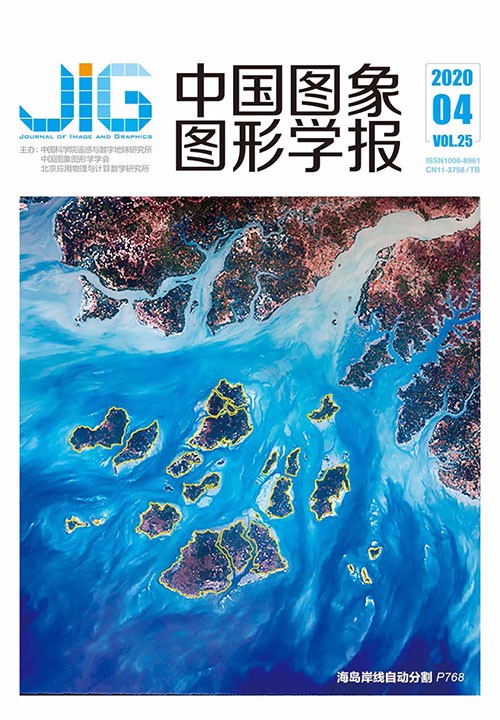
结合混沌鸟群算法的阴极铜板表面缺陷检测
摘 要
目的 铜电解过程中常因电解液溶解气体过饱阻止铜离子析出而在铜板表面形成凸起,常由操作员目视对铜板表面质量进行鉴别以决定归类,针对人工判别电解阴极铜板表面质量准确度和效率都较低的问题,提出一种结合混沌鸟群算法的铜板表面凸起智能识别方法。方法 为增强算法的全局搜索能力,引入鸟群算法;选取鸟群劣质个体交替进行混和动态步长位置更新增加种群多样性以免陷入局部最优;对铜板表面缺陷进行分析,提出基点生长法并结合形态学开操作消除铜板图像纹理以提高算法对凸起面积计算的准确性。将最佳熵阈值确定法(Kapur-Sahoo-Wong,KSW)作为鸟群算法的适应度函数对铜板图像进行阈值分割,通过统计分割图像凸起像素点个数,得到实际凸起面积占比以决定铜板是否合格。结果 将本文算法与遗传算法(genetic algorithm,GA)、鸡群算法(chicken swarm optimization,CSO)、萤火虫算法(glowworm swarm optimization,GSO)及鸟群算法(bird swarm algorithm,BSA)4种算法分别在时间、适应度值和结构相似度(structural similarity index measurement,SSIM)3个指标下分析对比,实验结果表明,本文算法适应度值可提高0.0030.701,SSIM值可提高0.0750.169。结论 本文方法能有效检测铜板表面凸起面积占比并对其进行合格品、次品分类。
关键词
Cathodic copper plate surface defect detection based on bird swarm algorithm with chaotic theory
Wang Zhuo1, Zhang Changsheng1, Li Wei1, Qian Junbing1, Tang Duzuo2, Cai Bing2, Chang Yitao2(1.Faculty of Information Engineering and Automation, Kunming University of Science and Technology, Kunming 650500, China;2.Copper Branch of Yunnan Tin Copper limited, Kunming 661400, China) Abstract
Objective From the global copper demand area, China still occupies the world's largest consumer of copper, accounting for nearly 40% of global total demand. Chinese economic data and news have been the focus of the copper market. In recent years, China's copper processing industry has shown a steady growth, and industry output gradually expanded. Copper processing materials are widely used in almost all national economy industries. Electrolytic copper plays an important role in copper smelting industry. During copper electrolysis, a large amount of air mixed in electrolyte is the main reason for the pores on the surface of copper cathode. The electrolyte dissolved gas is oversaturated to produce gas phase core, which gradually grows to form bubbles, and attaches to the surface of the cathode copper plate to form insulation point. This condition hinders the precipitation of copper ions, resulting in the appearance of bumps on the surface quality of copper plate. The surface quality of the copper plate is usually identified by the operator's eyes to determine the classification to solve the problem of low accuracy and efficiency of manually discriminating the surface quality of electrolytic cathode copper plate. This study proposes an intelligent recognition method of copper plate surface-raised image based on chaotic bird swarm algorithm. Method To enhance the global searching ability of the algorithm, the chaos theory is improved to make it enter into a completely chaotic state. The improved chaos theory was introduced based on the local optimal judgment of birds' own fitness value. In the iteration of bird flock, low-quality individuals were selected alternately to carry out chaos and dynamic step position update to increase the population diversity to avoid local optimization of the algorithm. Based on the analysis of surface defects of the copper plate, the base point growth method is proposed to design and detect structural elements. In addition, the texture of copper plate image is eliminated by combining with the morphological operation to improve the algorithm accuracy in calculating the raised area. The birds used Kapur-Sahoo-Wong(KSW) entropy as the fitness function to segment the copper plate images at the best threshold. Background pixels are mixed with raised category pixels in the initial segmentation result due to uneven illumination. Therefore, this study classifies the pixel of the corrected copper plate image through eight neighborhood search and takes it as the final segmentation result. According to the statistics of the number of raised pixels in the segmented image, the actual raised area proportion is obtained to determine whether the copper plate is qualified or defective. In this work, three copper plates with the smallest raised area are selected from 30 copper plates with fixed defective products through rough recognition by the human eyes. The exact bulge ratio is calculated using the algorithm in this study. To strengthen the fault tolerance rate of the algorithm, appropriate adjustment was made on the basis of the minimum value as the final threshold of copper plate classification. In addition, two arbitrary copper plates were selected to verify the method. Result The algorithm in this study is compared with genetic algorithm(GA), chicken swarm optimization(CSO), glowworm swarm optimization(GSO), and bird swarm algorithm(BSA) in three indexes of time, fitness value, and structural similarity index measurement(SSIM) value, respectively. Experimental results show that the fitness value of the algorithm in this study was increased by 0.0030.701, and the SSIM value was increased by 0.0750.169.The finding reveals the fault tolerance and superiority of this algorithm in the calculation of the proportion of copper plate surface bulge. Conclusion The proposed method can effectively detect the proportion of copper surface bulge area and classify qualified and defective products, thus providing a reference to determine the surface quality of electrolytic copper in metallurgical industry.
Keywords
copper plate defects threshold segmentation bird swarm algorithm(BSA) chaos theory base growth method Kapur-Sahoo-Wong(KSW) entropy method
|



 中国图象图形学报 │ 京ICP备05080539号-4 │ 本系统由
中国图象图形学报 │ 京ICP备05080539号-4 │ 本系统由